The Influence of Education, Capital, and Technology Levels on the Competitiveness of Micro, Small, and Medium Enterprises (MSMEs) as Supporters of Sustainable Development in Sawan District
DOI:
https://doi.org/10.18502/kss.v9i21.16774Abstract
This research aims to determine the role of external factors influencing the growth of MSMEs in supporting sustainable development. Of the 2365 MSME owners in the District of Sawan, a sample of 343 respondents was determined using the Slovin’s formula. Data were obtained through interviews and questionnaires using multiple regression analysis techniques. Results of the study proves that (1) the level of education and the capital has a partially significant influence on the competitiveness of MSME businesses in the District of Sawan while technology has no significant effect; (2) the level of education, capital, and technology has a significant influence on the competitiveness of the MSMEs in the Subdistrict of Sawan; and (3) the magnitude of the effect of the level of education, capital, and technology to power the competitiveness of SMEs is at 51.3%, while 48.7% are influenced by variables that were not tested in the study.
Keywords: MSME, sustainable development, economic growth
References
Agyapong D. Micro, small and medium enterprises’ activities, income level and poverty reduction in ghana-A synthesis of related literature. Int J Bus Manage. 2010;5(12):196. DOI: https://doi.org/10.5539/ijbm.v5n12p196
Aris NM. SMEs: Building blocks for economic growth. Malaysia: Department of National Statistics; 2007.
Assembly, G. (2015). Sustainable development goals. SDGs Transform Our World, 2030.
Bhasin BB, Venkataramany S. Globalization of entrepreneurship: policy considerations for SME development in Indonesia [IBER]. Int Bus Econ Res J. 2010;9(4). https://doi.org/10.19030/iber.v9i4.557. DOI: https://doi.org/10.19030/iber.v9i4.557
Carvalho L, Costa T. Small and medium enterprises (SMEs) and competitiveness: an empirical study. J Manage Stud. 2014;2(2):88–95.
Castrogiovanni GJ, Urbano D, Loras J. Linking corporate entrepreneurship and human resource management in SMEs. Int J Manpow. 2011;32(1):34–47. DOI: https://doi.org/10.1108/01437721111121215
Dinas Perdagangan, Perindustrian, Koperasi dan UKM Kabupaten Buleleng. (2019). Jumlah UMKM di Kabupaten Buleleng 2019. Buleleng.
Endang Purwanti, Pengaruh Karakteristik Wirausaha, Modal Usaha, Strategi Pemasaran terhadap Perkembangan UMKM Di Desa Dayaan dan Kalilondo Salatiga, Among Makarti, Vol.5, ( Juli;2012)
Gupta, S. L., & Ranjan, R. (2014). Impact of liberalization on contribution of MSMEs in economic development of India. Economic survey, 2012, 13.
Harvie, C. (2004). East Asian SME capacity building, competitiveness and market opportunities in a global economy.
Harvie, C. (2010). East Asian production networks–the role and contribution of SMEs.
Harvie, C., & Lee, B. C. (2002). East Asian SMEs: Contemporary Issues and Developments-An Overview. The role of SMEs in national economies in East Asia, 1-20. DOI: https://doi.org/10.4337/9781782543701.00008
Hodorogel, R. G. (2009). The economic crisis and its effects on SMEs. Theoretical & Applied Economics, 16(5).
Maflikhah N. Peran Teknologi Informasi Pada Niat Untuk Mendorong Knowlegde Sharing Karyawan SEkretariat Daerah Pemerintah Kota Surakarta (Sebuah Pengujian Terhadap Teori Difusi Inovasi). Surakarta: Jurnal Ekonomi Universitas Sebelas Maret; 2010.
Yusuf M. Pengantar ilmu Pendidikan. Jakarta: Ghalia; 1982.
Pemerintah Republik Indonesia. Undang-Undang Nomor 20 Tahun 2008 tentang Usaha Mikro Kecil Menengah. UU UMKM; 2013.
Putri Kd. Pengaruh Karakteristik Kewirausahaan. Jurnal Ilmu Administrasi Bisnis UNDP Semarang; n.d.
Rudjito. (2003). Stratrgi Pengembangan Umkm Berbasis Strategi Bisnis, Makalah Yang Di Sampaikan Pada Seminar Peran Perbankan Dalam Memperkokoh Ketahanan Nasional Kerjasama Lemhanas RI Dengan BRI.
Sadiqin, A. (2020). MICRO, SMALL AND MEDIUM BUSINESS DEVELOPMENT (UMKM) AS A MEANING STRENGTH IN THE ECONOMIC PILLAR OF MEA. MICRO, SMALL AND MEDIUM BUSINESS DEVELOPMENT (UMKM) AS A MEANING STRENGTH IN THE ECONOMIC PILLAR OF MEA, 4(04), 58-65.
Sedyastuti K, Suwarni E, Rahadi DR, Handayani MA. (2021, April). Human Resources Competency at Micro, Small and Medium Enterprises in Palembang Songket Industry. In 2nd Annual Conference on Social Science and Humanities (ANCOSH 2020) (pp. 248-251). Atlantis Press. DOI: https://doi.org/10.2991/assehr.k.210413.057
Sugiyono. (2014). Statistika Untuk Penelitian. Bandung: CV Alfabeta.
Suharyadi dan Purwanto.2004.Metodelogi Penelitian.Jakarta:GramediaPustaka Utama.
Suparmoko, & Irawan. (2003). Ekonomika Pembangunan. Edisi keenam. Yogyakarta: BPFE UGM.
Surya B, Menne F, Sabhan H, Suriani S, Abubakar H, Idris M. Economic growth, increasing productivity of SMEs, and open innovation. J Open Innov. 2021;7(1):20. DOI: https://doi.org/10.3390/joitmc7010020
Tambunan T. Promoting small and medium enterprises with a clustering approach: A policy experience from Indonesia. J Small Bus Manag. 2005;43(2):138–54. DOI: https://doi.org/10.1111/j.1540-627X.2005.00130.x
Tambunan T. Usaha Mikro, Kecil, dan Menengah. Jakarta: Ghalia Indonesia; 2017.
Todd, P. R., & Javalgi, R. R. G. (2007). Internationalization of SMEs in India: Fostering entrepreneurship by leveraging information technology. International journal of emerging markets. DOI: https://doi.org/10.1108/17468800710739234
Utari, Tri dan Putu Martini Dewi, Pengaruh Modal, Tingkat Pendidikan dan Teknologi Terhadap Pendapatan Usaha Mikro Kecil dan Menengah (UMKM) di Kawasan Imam Bonjol Denpasar Barat, EP Unud. Volume 3. Desember; 2014.
Venkatesh, S., & Muthiah, K. (2012). SMEs in India: Importance and contribution.
Wulansari A. Menuju Ekonomi Berdikari Pemberdayaan UMKM Dengan Konsep Opop-Ovp-Ovoc. Yogyakarta: Media Pressin; 2015.
Yuniarta, G. A. (2017). Program Pendampingan Wirausaha Dalam Rangka Peningkatan Daya Saing UMKM di Kabupaten Buleleng., 2. DOI: https://doi.org/10.23887/team.Vol2.2017.155

